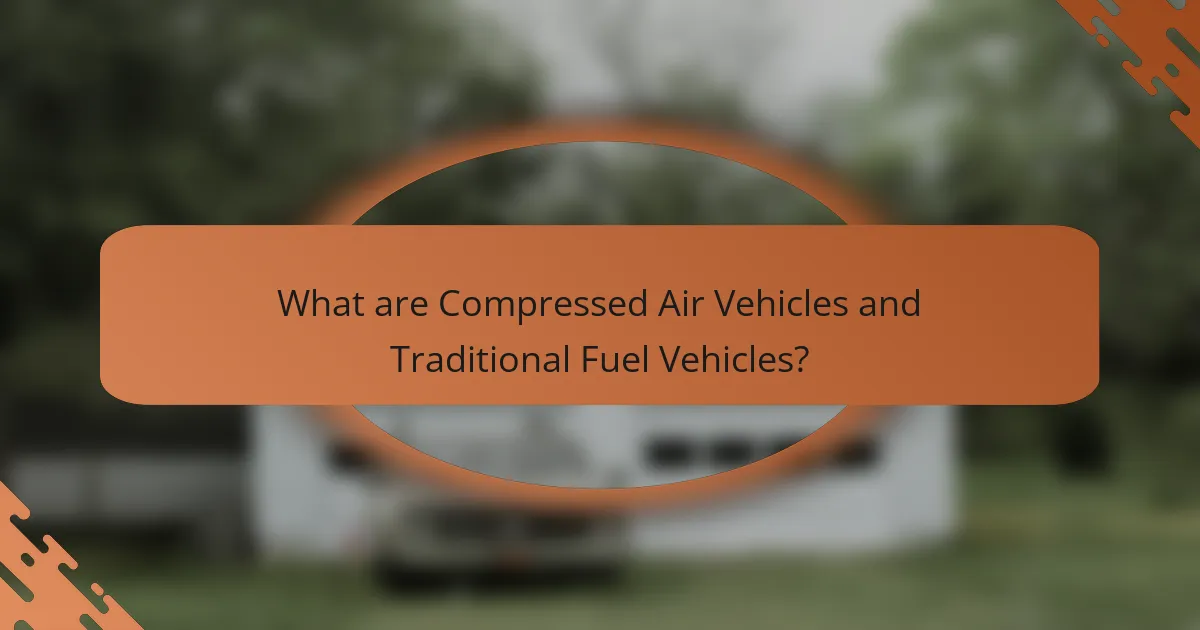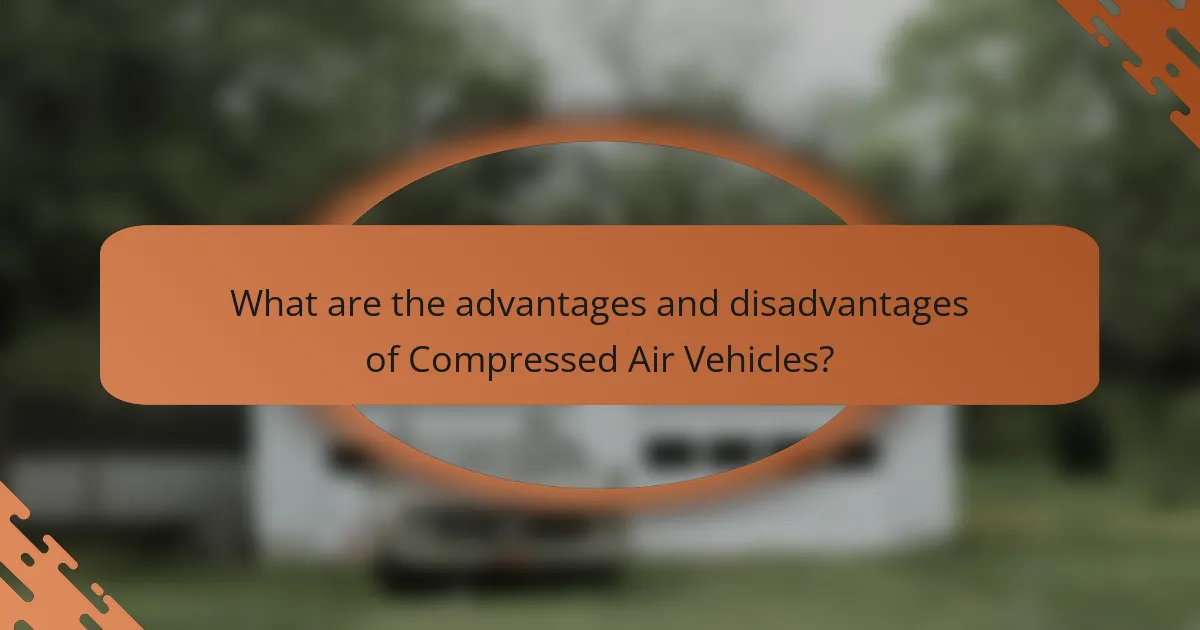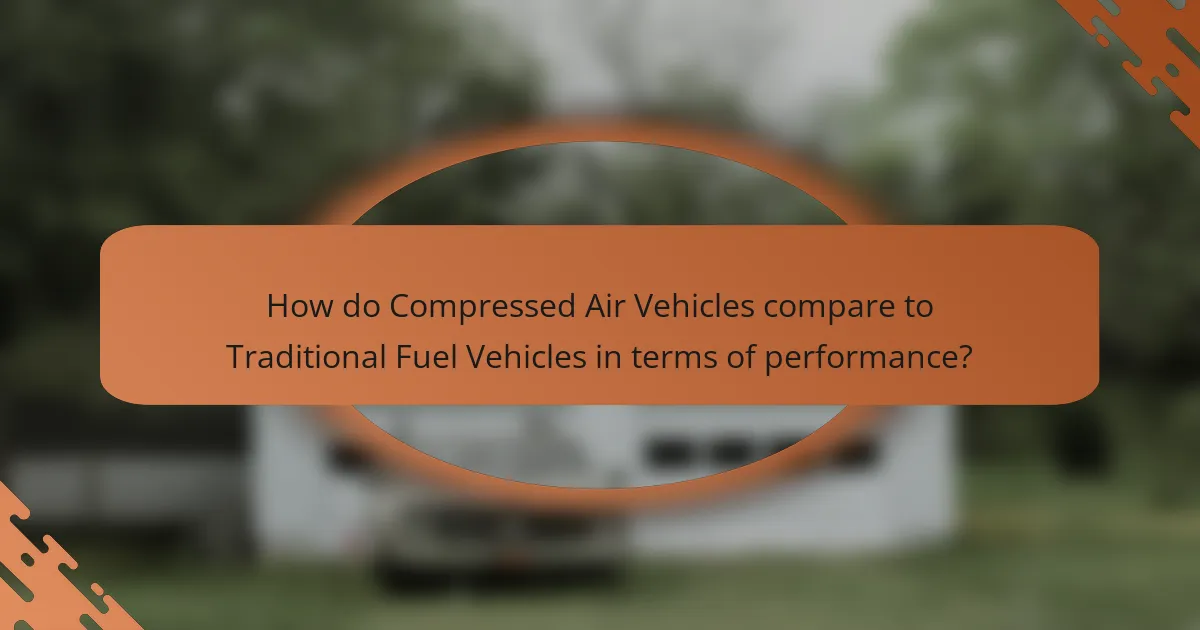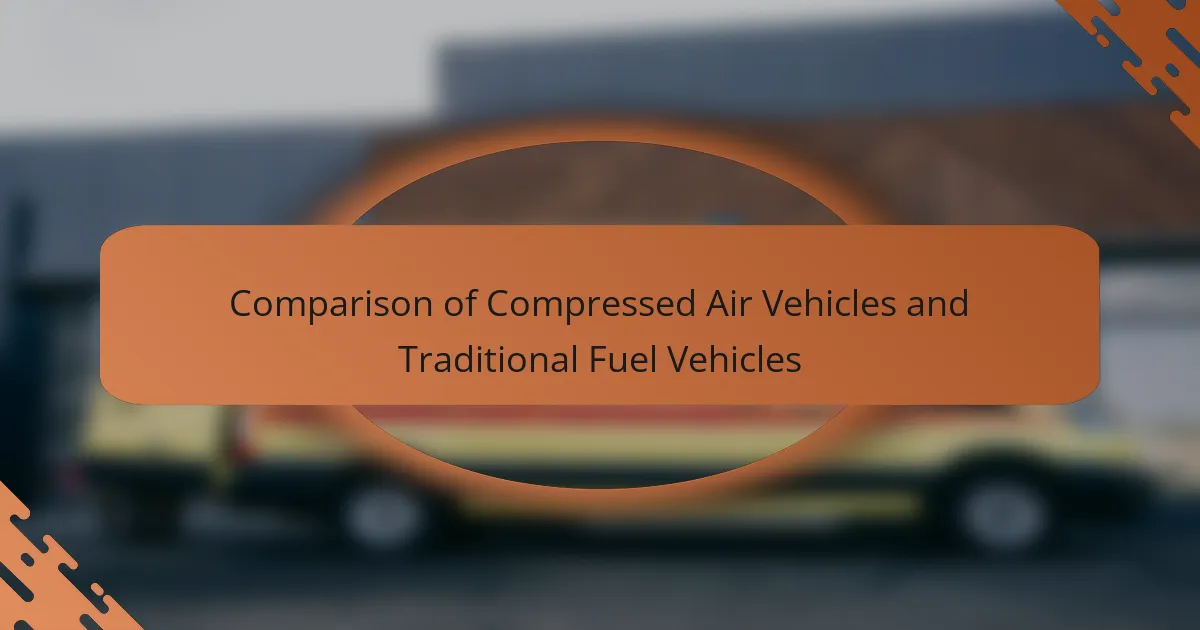Compressed Air Vehicles (CAVs) utilize compressed air as a propulsion power source, offering a cleaner alternative to Traditional Fuel Vehicles (TFVs) that rely on gasoline or diesel. CAVs produce zero emissions and have lower operational costs, but they face limitations such as reduced driving range, lack of refueling infrastructure, and performance issues in colder temperatures. This article compares the environmental impact, efficiency, and performance characteristics of CAVs and TFVs, highlighting the advantages and disadvantages of each vehicle type. Key factors discussed include energy sources, maintenance costs, and the current state of technology and infrastructure for compressed air vehicles.

What are Compressed Air Vehicles and Traditional Fuel Vehicles?
Compressed Air Vehicles (CAVs) utilize compressed air as a power source for propulsion. These vehicles store air in high-pressure tanks and release it to drive pistons or turbines. This technology aims to reduce reliance on fossil fuels and minimize emissions. Traditional Fuel Vehicles (TFVs) operate using internal combustion engines powered by gasoline or diesel. TFVs emit greenhouse gases and other pollutants during operation. The main distinction lies in their energy sources and environmental impact. CAVs offer a cleaner alternative, while TFVs contribute to air pollution.
How do Compressed Air Vehicles operate compared to Traditional Fuel Vehicles?
Compressed Air Vehicles operate by using compressed air as a power source, while Traditional Fuel Vehicles rely on combustion of fossil fuels. Compressed Air Vehicles store air in high-pressure tanks. This air is then released to drive pistons that turn the wheels. They produce zero emissions during operation. In contrast, Traditional Fuel Vehicles burn gasoline or diesel, releasing pollutants into the environment. Compressed Air Vehicles tend to have lower energy density compared to fuel-based systems. Traditional Fuel Vehicles typically offer greater range and faster refueling times. Additionally, Compressed Air Vehicles require specialized infrastructure for air compression and refueling.
What are the key components of Compressed Air Vehicles?
The key components of Compressed Air Vehicles (CAVs) include the air storage tank, compressor, engine, and control system. The air storage tank holds compressed air at high pressure, typically around 300 to 450 psi. The compressor is responsible for compressing ambient air into the storage tank. The engine converts the compressed air into mechanical energy to power the vehicle. The control system regulates air flow and pressure to ensure efficient operation. These components work together to enable the vehicle to operate effectively without traditional fuel sources.
What are the key components of Traditional Fuel Vehicles?
The key components of traditional fuel vehicles include the internal combustion engine, fuel system, transmission, and exhaust system. The internal combustion engine converts fuel into mechanical energy. The fuel system stores and delivers fuel to the engine. The transmission transfers power from the engine to the wheels. The exhaust system expels combustion gases from the engine. These components work together to enable vehicle operation. Each component plays a crucial role in the overall functionality of traditional fuel vehicles.
What are the environmental impacts of Compressed Air Vehicles versus Traditional Fuel Vehicles?
Compressed Air Vehicles (CAVs) generally have a lower environmental impact compared to Traditional Fuel Vehicles (TFVs). CAVs produce zero tailpipe emissions, which significantly reduces air pollution in urban areas. In contrast, TFVs emit greenhouse gases and pollutants, contributing to climate change and respiratory issues. The manufacturing process of CAVs can still involve emissions, but they are typically less than those from producing internal combustion engines. Additionally, CAVs utilize renewable energy sources for compression, further minimizing their carbon footprint. Studies indicate that transitioning to CAVs could lead to a reduction in fossil fuel dependency. In summary, CAVs offer a cleaner alternative in terms of emissions and energy use compared to TFVs.
How do emissions compare between Compressed Air Vehicles and Traditional Fuel Vehicles?
Compressed Air Vehicles (CAVs) produce significantly lower emissions compared to Traditional Fuel Vehicles (TFVs). CAVs primarily emit air, as they operate using compressed air as a power source. In contrast, TFVs release carbon dioxide, nitrogen oxides, and other pollutants due to combustion of fossil fuels. Studies indicate that CAVs can reduce greenhouse gas emissions by up to 90% compared to conventional vehicles. Additionally, CAVs contribute to improved air quality in urban areas. This reduction in emissions aligns with global efforts to combat climate change and promote sustainable transportation.
What is the energy efficiency of Compressed Air Vehicles compared to Traditional Fuel Vehicles?
Compressed Air Vehicles (CAVs) are generally more energy-efficient than Traditional Fuel Vehicles (TFVs). CAVs convert compressed air into mechanical energy, achieving efficiencies of about 50-70%. In contrast, TFVs typically operate at efficiencies of 20-30% due to energy losses in combustion and heat. Research indicates that CAVs can utilize energy more effectively, leading to lower operational costs and reduced emissions. A study by the International Journal of Hydrogen Energy found that CAVs can reduce energy consumption by up to 80% compared to gasoline engines. This data supports the conclusion that CAVs offer a significant advantage in energy efficiency over TFVs.

What are the advantages and disadvantages of Compressed Air Vehicles?
Compressed Air Vehicles (CAVs) offer several advantages and disadvantages. The primary advantage is their environmental friendliness. CAVs produce zero emissions during operation. This contributes to reduced air pollution. They also have lower operational costs compared to traditional fuel vehicles. Compressed air is often cheaper than gasoline or diesel.
Another advantage is the simplicity of the technology. CAVs have fewer moving parts than internal combustion engines. This can lead to lower maintenance costs. Additionally, CAVs can be refueled quickly at dedicated stations.
However, there are notable disadvantages. CAVs typically have limited range compared to traditional fuel vehicles. The energy density of compressed air is lower than that of gasoline. This results in shorter driving distances before refueling is needed.
Another disadvantage is the current lack of infrastructure. Refueling stations for CAVs are not widely available. This can limit their practicality for everyday use. Furthermore, the performance of CAVs can be affected by temperature variations. Cold weather can reduce the efficiency of compressed air systems.
In summary, while CAVs are environmentally friendly and cost-effective, they face challenges related to range, infrastructure, and performance.
What benefits do Compressed Air Vehicles provide over Traditional Fuel Vehicles?
Compressed Air Vehicles (CAVs) offer several benefits over Traditional Fuel Vehicles (TFVs). CAVs produce zero tailpipe emissions, contributing to cleaner air quality. They operate using compressed air, which is a renewable energy source. This reduces dependence on fossil fuels, promoting energy sustainability. CAVs generally have lower operating costs due to reduced fuel expenses. Maintenance requirements are also lower, as they have fewer moving parts compared to TFVs. Additionally, CAVs can be refueled quickly at specialized stations. These advantages position CAVs as a more environmentally friendly and cost-effective alternative to traditional vehicles.
How do operating costs differ between Compressed Air Vehicles and Traditional Fuel Vehicles?
Operating costs for Compressed Air Vehicles (CAVs) are generally lower than those for Traditional Fuel Vehicles (TFVs). CAVs primarily incur costs related to electricity for compression and maintenance. In contrast, TFVs face expenses from fuel purchases, oil changes, and more complex engine maintenance.
The cost of electricity for CAVs averages around $0.10 per kWh. This translates to approximately $2.00 for a full charge, allowing for significant savings compared to gasoline or diesel. Traditional fuel prices fluctuate, but average costs can be around $3.00 per gallon.
Maintenance for CAVs is typically less frequent and less expensive due to fewer moving parts. TFVs require regular oil changes and engine repairs, which can add up over time. Overall, the operational efficiency of CAVs leads to reduced long-term costs compared to TFVs.
What are the maintenance requirements for Compressed Air Vehicles?
Compressed Air Vehicles require regular maintenance to ensure optimal performance. Key maintenance tasks include checking air tanks for leaks and ensuring proper pressure levels. The filtration system must be inspected and cleaned periodically to prevent contaminants. Additionally, components like valves and regulators should be checked for functionality. Routine inspections of the drive system are also essential to maintain efficiency. Unlike traditional fuel vehicles, compressed air vehicles have fewer moving parts, which can reduce overall maintenance frequency. However, specialized knowledge may be needed for repairs and servicing.
What challenges do Compressed Air Vehicles face in the market?
Compressed Air Vehicles face several challenges in the market. Limited range is a significant issue, as these vehicles typically can only travel shorter distances compared to traditional fuel vehicles. The energy density of compressed air is lower than gasoline or diesel, leading to frequent refueling needs. Infrastructure for refueling compressed air vehicles is also underdeveloped. Few refueling stations exist, making it inconvenient for users. Additionally, the technology for compressed air storage is still evolving. Current systems can be bulky and expensive to produce. There are also regulatory hurdles to overcome, as safety standards for compressed air systems are not fully established. Lastly, consumer awareness and acceptance remain low, impacting market demand.
How does infrastructure impact the adoption of Compressed Air Vehicles?
Infrastructure significantly impacts the adoption of Compressed Air Vehicles (CAVs). Adequate refueling stations are essential for their widespread use. Currently, the limited availability of compressed air refueling stations hinders consumer acceptance. A robust network of these stations would facilitate easier access for users. Additionally, infrastructure for maintenance and repair is crucial for vehicle longevity. Lack of specialized service centers can deter potential buyers. Research indicates that regions with developed refueling infrastructure see higher adoption rates. For instance, cities with established CAV networks report increased sales and user satisfaction. Thus, enhancing infrastructure is vital for the growth of CAV adoption.
What are the limitations in technology for Compressed Air Vehicles?
Compressed Air Vehicles (CAVs) face several technological limitations. One major limitation is energy density. Compressed air has a lower energy density compared to traditional fuels. This results in shorter driving ranges for CAVs. Another limitation is efficiency. The process of compressing air and converting it back to kinetic energy is less efficient than combustion engines. Additionally, there are challenges with storage. High-pressure tanks are required, which can be heavy and expensive. Temperature effects also pose a problem. As air expands, it cools, reducing power output. Finally, infrastructure for refueling CAVs is limited. This restricts widespread adoption and usability in many regions.

How do Compressed Air Vehicles compare to Traditional Fuel Vehicles in terms of performance?
Compressed air vehicles generally have lower performance compared to traditional fuel vehicles. They typically offer lower top speeds and acceleration due to the limitations of compressed air propulsion. Compressed air vehicles often have a reduced range, averaging around 100 miles on a full tank of compressed air. In contrast, traditional fuel vehicles can achieve ranges exceeding 400 miles on a full tank. Additionally, compressed air vehicles experience performance degradation in colder temperatures, affecting efficiency. Traditional fuel vehicles maintain consistent performance across a broader range of environmental conditions. Furthermore, compressed air technology is still developing, which may limit the current performance capabilities compared to well-established internal combustion engines.
What are the speed and range capabilities of Compressed Air Vehicles?
Compressed Air Vehicles (CAVs) typically have speed capabilities ranging from 30 to 70 miles per hour. Their range is generally limited to about 100 to 200 miles on a single charge of compressed air. This performance is influenced by factors such as vehicle design and air tank capacity. For example, the AirPod, a prototype CAV, achieves speeds of around 50 mph and a range of approximately 120 miles. These capabilities are significantly lower compared to traditional fuel vehicles, which often exceed speeds of 100 mph and have ranges of over 400 miles.
How does acceleration in Compressed Air Vehicles compare to Traditional Fuel Vehicles?
Compressed Air Vehicles generally have slower acceleration compared to Traditional Fuel Vehicles. Traditional Fuel Vehicles often achieve higher torque and power output due to internal combustion engines. This allows them to accelerate more rapidly. In contrast, Compressed Air Vehicles rely on the expansion of compressed air, which typically results in less immediate power delivery.
For instance, Traditional Fuel Vehicles can go from 0 to 60 mph in around 6 seconds, depending on the model. Compressed Air Vehicles, however, may take significantly longer to reach similar speeds. The efficiency of energy conversion in fuel vehicles contributes to their superior acceleration capabilities.
What is the range of Compressed Air Vehicles on a full charge compared to Traditional Fuel Vehicles on a full tank?
Compressed Air Vehicles typically have a range of 100 to 200 miles on a full charge. In contrast, Traditional Fuel Vehicles can achieve ranges of 300 to 500 miles on a full tank. The difference in range is primarily due to the energy density of compressed air compared to gasoline. Gasoline has a higher energy content, allowing Traditional Fuel Vehicles to travel farther. This disparity highlights the current limitations of Compressed Air Vehicles in terms of range efficiency.
What future developments are expected for Compressed Air Vehicles?
Future developments for compressed air vehicles include advancements in efficiency and storage technology. Research focuses on increasing the energy density of compressed air systems. Innovations aim to reduce the size and weight of air tanks. Enhanced materials for tanks could improve safety and durability. Additionally, integration with renewable energy sources is being explored. This could allow for on-site compression using solar or wind energy. Companies are also investigating hybrid systems combining compressed air with electric propulsion. These developments aim to enhance the practicality and adoption of compressed air vehicles in the automotive market.
How is technology evolving to improve Compressed Air Vehicles?
Technology is evolving to improve Compressed Air Vehicles (CAVs) through advancements in energy storage and propulsion systems. Innovations in lightweight materials enhance vehicle efficiency and performance. Improved compressors increase the energy density of compressed air, allowing for longer driving ranges. Enhanced control systems optimize air usage, maximizing vehicle performance. Research into hybrid systems integrates compressed air with electric power, broadening operational capabilities. Additionally, advancements in safety features ensure better handling and reliability. These developments collectively contribute to the viability of CAVs as a sustainable transportation option.
What role do regulations play in the future of Compressed Air Vehicles?
Regulations are crucial for the future of Compressed Air Vehicles (CAVs). They establish safety standards for vehicle design and operation. Compliance with emissions regulations can enhance the marketability of CAVs. Incentives from governments may promote research and development in this sector. Regulations can also dictate infrastructure requirements for refueling stations. Furthermore, they influence consumer acceptance through safety and performance benchmarks. Regulatory frameworks can encourage investment in CAV technology. Overall, regulations shape the competitive landscape for CAVs compared to traditional fuel vehicles.
What practical considerations should consumers keep in mind when choosing between Compressed Air Vehicles and Traditional Fuel Vehicles?
Consumers should consider several practical factors when choosing between Compressed Air Vehicles (CAVs) and Traditional Fuel Vehicles (TFVs). Key considerations include cost, availability, and environmental impact. CAVs generally have lower operational costs due to cheaper energy sources. However, the initial purchase price may be higher compared to TFVs. Availability of refueling stations is crucial; CAV refueling infrastructure is limited in many areas. In contrast, TFVs benefit from widespread fuel stations. Performance and range are also important; CAVs often have shorter driving ranges and longer refueling times. Additionally, consumers should assess the environmental impact; CAVs produce zero emissions during operation, while TFVs contribute to air pollution. Maintenance requirements differ as well; CAVs typically have fewer moving parts, potentially leading to lower maintenance costs. Overall, consumers must weigh these factors based on their individual needs and circumstances.
The main entity of this article is the comparison between Compressed Air Vehicles (CAVs) and Traditional Fuel Vehicles (TFVs). The article explores the operational mechanisms, environmental impacts, and performance differences of both vehicle types. Key components, advantages, and disadvantages of CAVs are discussed, highlighting their zero emissions and lower operational costs compared to TFVs, which rely on fossil fuels and produce greenhouse gases. Additionally, the article addresses challenges such as range limitations and infrastructure needs for CAVs, along with future developments in technology and regulations that could influence their adoption in the automotive market.
